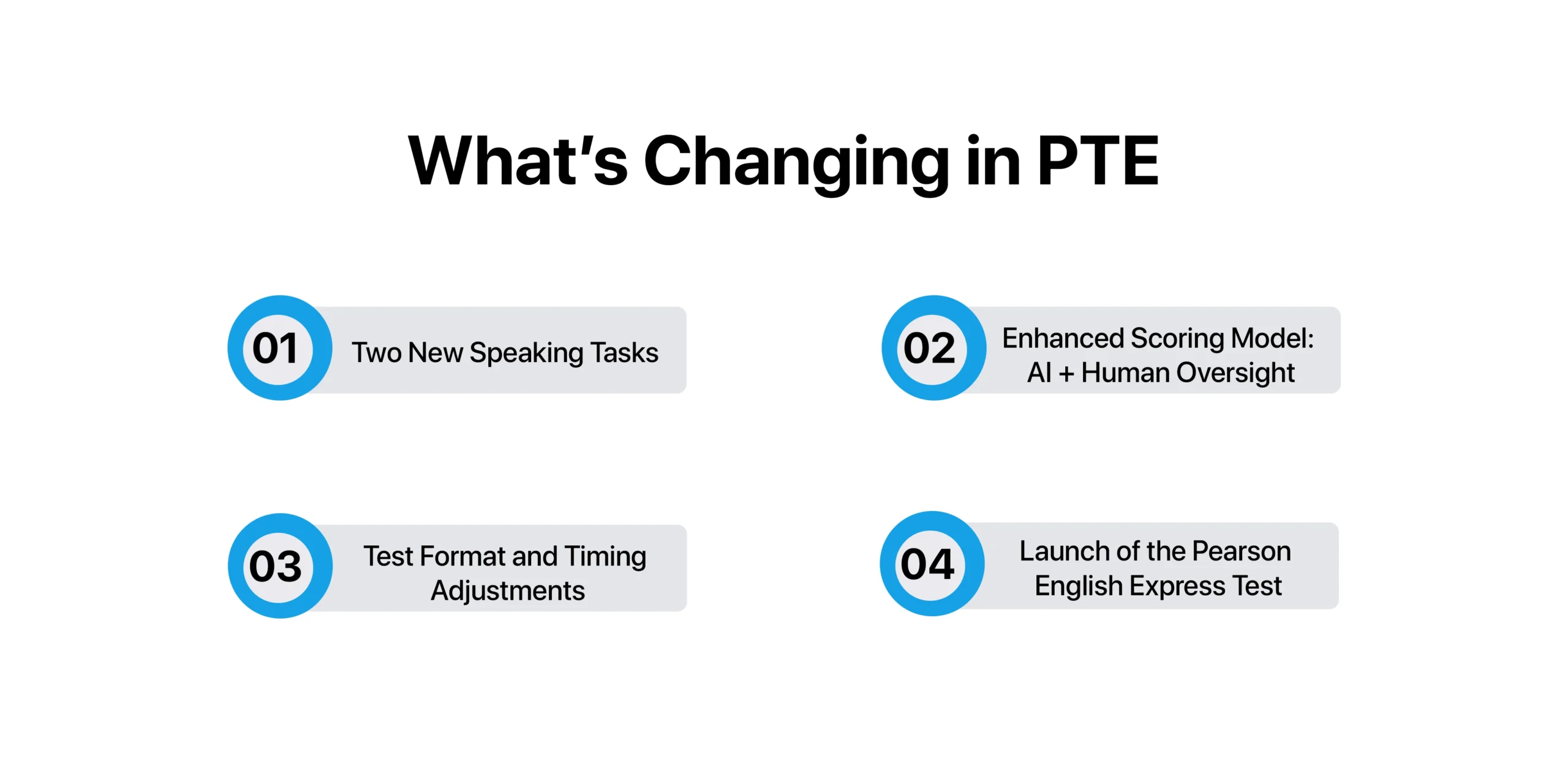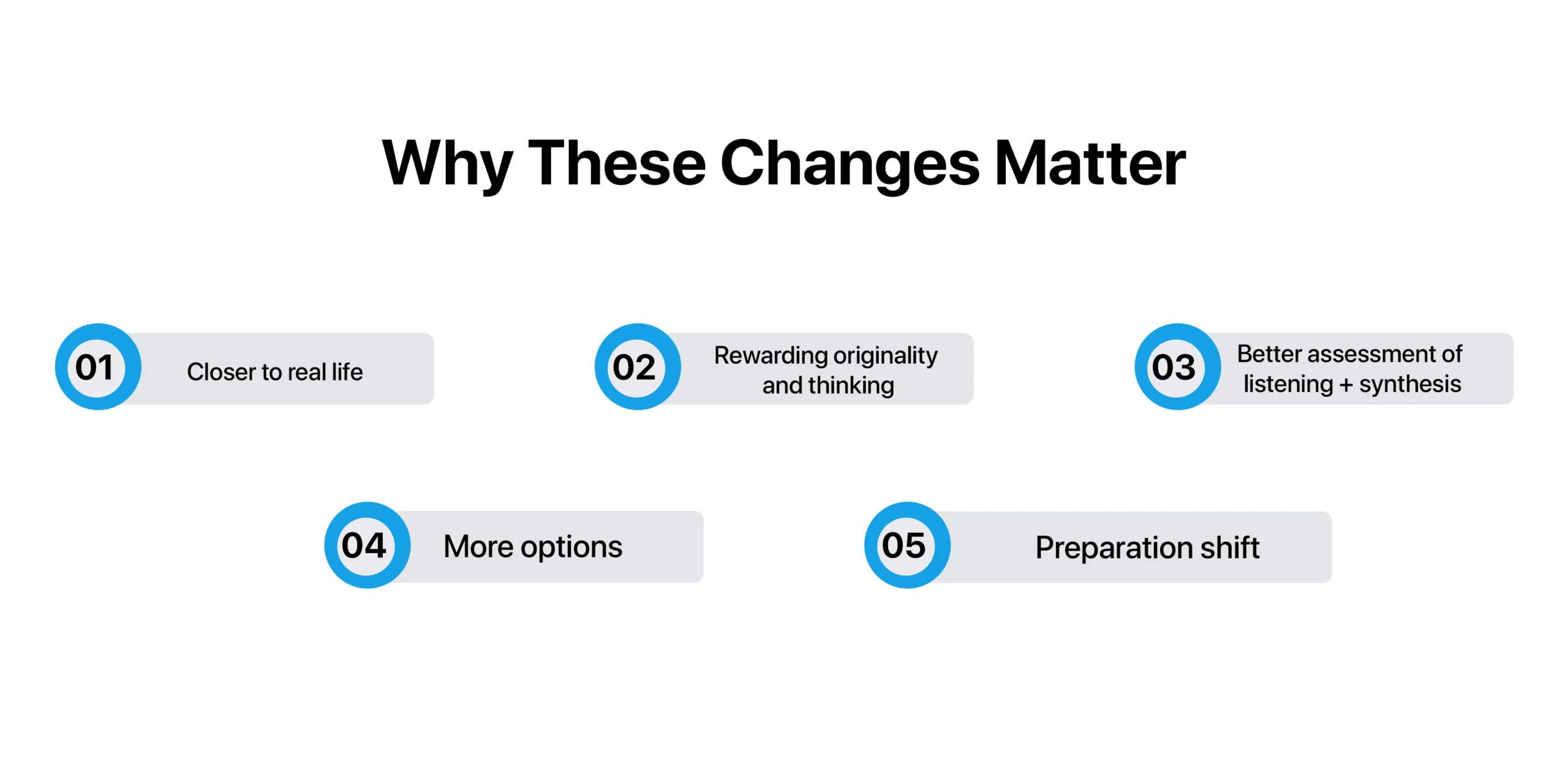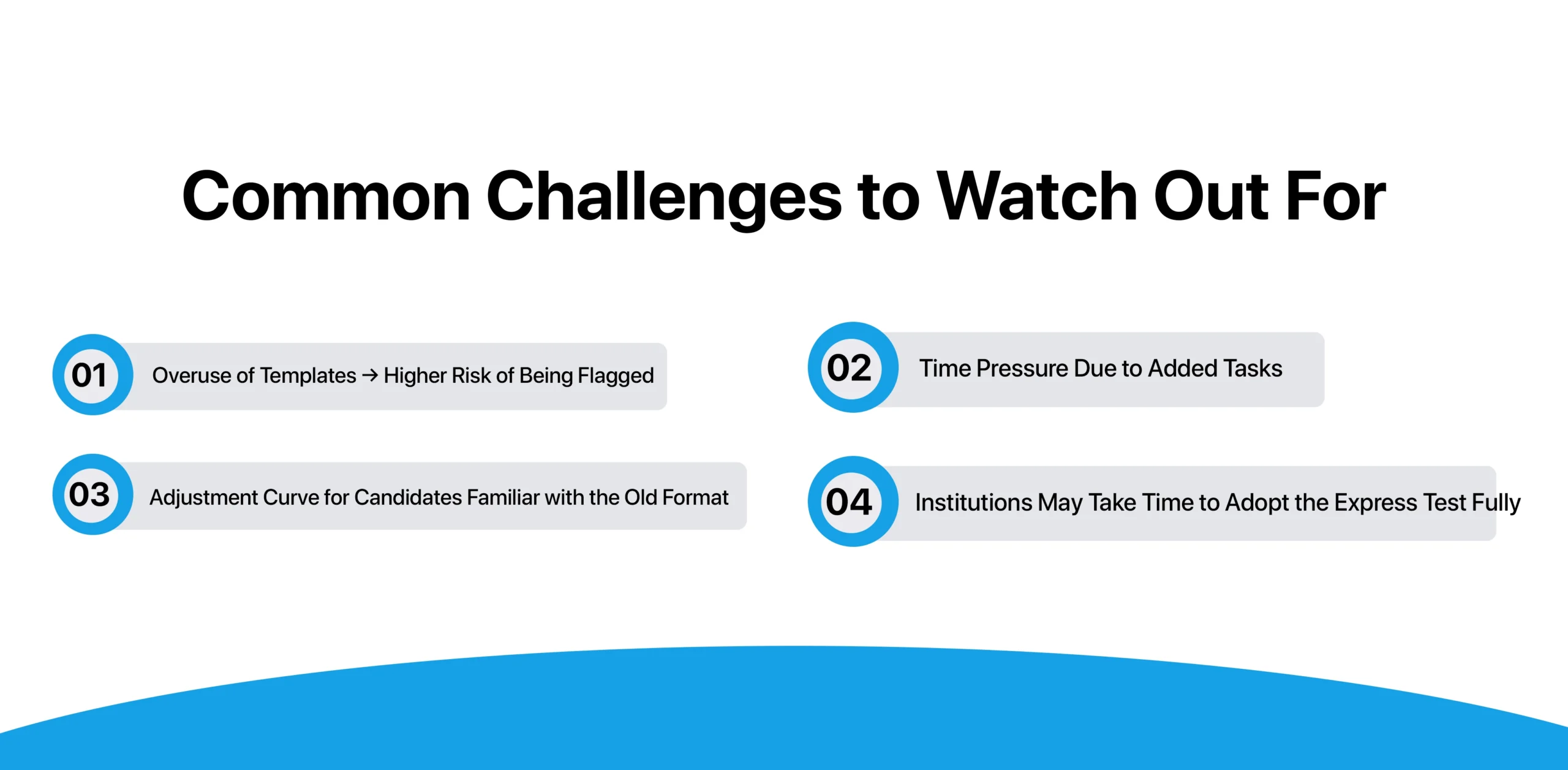The Pearson Test of English (PTE) is being developed. Pearson will implement significant changes to make the test more realistic in the actual communication process and implement a new variant named Express. These reforms are some of the latest PTE reforms in years. This post provides a breakdown of what is new, what remains the same, why it is important, and how you should prepare.
What’s Changing in PTE

1. Two New Speaking Tasks
Pearson is also including ‘Respond to a Situation’ and ‘Summarise Group Discussion’ in the PTE Academic speaking section.
a. Respond to a Situation
You will be presented with a short situation in this activity (usually with a verbal prompt), and you will have to answer in verbal English. Consider the daily communication: apologising, giving instructions, changing plans, etc.
b. Summarise Group Discussion
Here, you will listen to a short multi-speaker discussion, then speak a concise summary of the main viewpoints. It challenges your skills in handling a variety of inputs and displaying fundamental concepts.
Due to these additions, the total number of types of items increases (20 to 22), and the time taken to do the test is slightly increased (approximately 10-15 minutes more) in order to fit these new tasks.
2. Enhanced Scoring Model: AI and Human Oversight
While PTE has long used AI to score responses, the updated model adds human review for selected tasks.
For longer, content-rich spoken answers (like the new tasks), trained human examiners will review responses to check for relevance, originality, and coherence.
The goal is to reduce overdependence on templates or memorised responses and to reward more natural, context-appropriate speech.
In addition, the detection tools for templated or overly familiar response patterns are improved, flagging responses that seem rote or formulaic for further review.
3. Test Format and Timing Adjustments
Because of the extra tasks, test time is lengthened (by approximately 10–15 minutes) to allow for more content.
The core structure—three sections (Speaking & Writing, Reading, Listening)—remains.
Many familiar tasks remain unchanged, though some have adjusted scoring contributions toward particular language skills (e.g. speaking, listening) under the revised scheme.
4. Launch of the Pearson English Express Test
Alongside the PTE Academic update, Pearson is introducing a new Pearson English Express Test.
This test is designed to be shorter (~1 hour) and online (taken at home or remotely), intended for markets where access to test centres is limited.
It gives fast results: certified reports delivered in under 48 hours.
Institutions will receive samples of written and spoken responses to verify authenticity.
The Express test is set to roll out in Q4 2025 in several countries (US, UK, parts of Europe, etc.), with more markets to follow.
What Remains the Same (Stability Amid Change)
Even with these updates, many familiar aspects of PTE are unchanged:
- It remains fully computer-based and primarily AI-scored.
- Fast result turnaround: most scores are still delivered within 48 hours.
- The 90-point scoring scale continues.
- Acceptance and recognition by institutions (universities, immigration bodies) remain intact.
- Existing preparation materials remain useful (though new materials reflecting the changes are being released)
Why These Changes Matter

1. Closer to real life
The new tasks emphasise real-world skills, such as responding to situations and summarising group conversations, which are everyday academic and workplace tasks.
2. Rewarding originality and thinking
With stronger anti-template detection and human review, candidates who think and speak on the spot (rather than relying on rehearsed scripts) have an advantage.
3. Better assessment of listening + synthesis
Summarise Group Discussion evaluates not just speaking, but also listening comprehension, information filtering, and summarisation skills.
4. More options
The Express test gives flexibility for learners in areas with limited test centre access.
5. Preparation shift
Candidates must now incorporate more spontaneous speaking, critical listening, and summarising skills into their preparation, not just memorising standard responses.
Common Challenges to Watch Out For

1. Overuse of Templates – Higher Risk of Being Flagged
Many PTE candidates memorise “universal” answers for tasks like Describe Image or Write Essay. While these templates used to work (because AI would reward structure and fluency), Pearson’s new AI and human review system is designed to detect overly repetitive or robotic responses.
Why it’s a problem:
Your score may be reduced if your response looks too generic.
Human reviewers will look for relevance and originality.
Over-reliance on templates reduces your ability to respond naturally in new speaking tasks like Respond to a Situation.
What to do instead:
- Add variety to vocabulary and sentence structure.
- Practice “thinking on your feet” by recording answers to random prompts.
- For writing, prepare a flexible essay structure, but always adapt the content to the exact question.
2. Time Pressure Due to Added Tasks
The test now includes 65–75 tasks (up from 52–64). With two new speaking tasks and extended timing, time management is more important than ever.
Why it’s a problem:
Spending too long on one task may leave you rushed for others.
The test is longer overall, so mental fatigue can affect performance.
Candidates who are not used to pacing themselves may run out of focus before the listening section.
What to do instead:
- Take full-length mock tests in the new format to build stamina.
- Practice giving concise answers — long doesn’t always mean better.
- Use note-taking shorthand for listening tasks (symbols, keywords).
- Train yourself to move on quickly — don’t dwell on one difficult question.
3. Adjustment Curve for Candidates Familiar with the Old Format
If you studied PTE before August 2025, you may be comfortable with the old scoring and task setup. The introduction of new tasks and human review means old strategies may no longer be as effective.
Why it’s a problem:
Materials and mock tests created before 2025 may not reflect the changes.
Candidates who relied on old shortcuts (like standard essay templates or repeated sentence tricks) may struggle.
It takes time to retrain yourself in active listening and spontaneous speaking.
What to do instead:
- Update your preparation resources to post-2025 study material.
- Re-train for new tasks: Respond to a Situation and Summarise Group Discussion.
- If you’ve taken PTE before, focus specifically on what’s new, rather than re-learning everything.
- Join PTE forums or groups to hear experiences from test-takers who’ve already taken the new format.
4. Institutions May Take Time to Adopt the Express Test Fully
The new Pearson English Express Test (1-hour, online) is designed for accessibility and fast results. But since it’s brand new, some universities, employers, or immigration bodies may not accept it immediately.
Why it’s a problem:
You might spend time preparing for Express only to find your target institution doesn’t accept it.
Recognition may vary between countries or even institutions.
If you need the test for an urgent visa or academic deadlines, relying on Express could be risky.
What to do instead:
- Always check acceptance policies before booking Express.
- If your institution requires PTE Academic, stick with the full test.
- Consider Express for quick, unofficial checks or applications where flexibility is allowed.
- Keep an eye on Pearson’s announcements—more institutions will adopt Express gradually.
Conclusion
The updates of the PTE 2025 are taken to make the exam more realistic, fair, and closer to the actual use of English in real life. Two further speaking tasks are introduced, and this time around, the candidates will be tested in their ability to think on their feet and with minimal thought preparation, which is closer to the kind of communication that they will do in academia and in the workplace.
Human review and AI scoring are the keys to the fact that originality and relevance are rightfully rewarded, and less emphasis is placed on memorised templates, and candidates are ready to write more natural and context-specific answers.
FAQs
1. What are the new updates for PTE 2025?
PTE 2025 introduces two new speaking tasks (Respond to a Situation and Summarise Group Discussion), human review for select tasks, a slight test duration extension, updated scoring rubrics, minor interface improvements, and the launch of a shorter Pearson English Express Test for faster, remote testing.
2. What is PTE Academic 2025?
PTE Academic is a 2-hour computer-based English test assessing Speaking, Writing, Reading, and Listening. It’s accepted for university admissions, work visas, and immigration. Results are usually available within 1–2 days.
3. How long is PTE valid for PR?
A PTE Academic score is valid for 3 years from the test date for Permanent Residency applications.
4. What is the PTE score limit?
The PTE Academic score ranges from 10 to 90, with 90 being the highest possible score.





